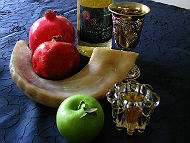
Rosh Hashanah is celebrated as the Jewish New Year. However, the term “Rosh Hashanah” does not actually appear in the Torah, but rather is referred to as the Feast of Trumpets, known as “Zikhron Teru’ah” in Leviticus 23:24 – “a memorial with the blowing of horns”. It is also referred to in the same part of Leviticus as a penultimate Sabbath or meditative rest day, and a “holy day to God”. It is the first of the High Holy Days (“Days of Awe”) which usually occur in the early autumn of the Northern Hemisphere and consist of Rosh Hashanah, Yom Kippur (Day of Atonement), and Sukkot (Feast of Tabernacles). The trumpets are meant to serve as a wakeup call, to bring the people to prayer and repentance in preparation for the coming Day of Atonement.
Rosh Hashanah is a two-day celebration, which begins on the first day of the seventh month of Tishrei. According to Jewish tradition, the day is believed to be the anniversary of the creation of Adam and Eve. The shofar is customarily blown each morning for the entire month of Elul (excluding on the Sabbath) preceding Rosh Hashanah in order to “awaken the listeners from their slumbers and alert them to the coming judgment.” During Rosh Hashanah prayers, the shofar is blown over a hundred times throughout the day in different blast sequences.
It is traditional to wish one another “Shana Tovah”, or a good year. Serious greetings and blessings, based on the nature of the day, commonly used among religiously observant Jews are “Ketivah VaChatimah Tovah” which means “may you be written and sealed [for a good new year i.e. by God].” After Rosh Hashanah ends, the greeting is abbreviated to “G’mar Chatimah Tovah” (“may you be finally sealed for a good [year by God]”) until Yom Kippur. After Yom Kippur is over, and until Sukkot ends, the greeting is “G’mar Tov” (“a good conclusion [of God’s judgment]”), which refers to the existing hope that a negative verdict is not final, and that those who were not written in the book of life may still be written by Sukkot. However, it is generally assumed that everyone was sealed for life, and therefore, Sukkot is often celebrated as “the time of our joy.”
“Speak to the people of Israel, saying, In the seventh month, on the first day of the month, you shall observe a day of solemn rest, a memorial proclaimed with blast of trumpets, a holy convocation.” Leviticus 23:24
The above describes three important stages as the spiritual order of the Ten Days of Repentance (the ten days between Rosh Hashanah and Yom Kippur) unfolds: The names of the righteous are immediately inscribed in the book of life, and they are sealed “to live.” The intermediate class are allowed a respite of ten days, until Yom Kippur, to reflect, repent and become righteous; the wicked are “blotted out of the book of the living forever”.
Many symbolic foods are eaten on Rosh Hashanah, such as apples dipped in honey to evoke a “sweet new year”, pomegranate seeds to symbolize plentiful fruitfulness, and round challah bread to symbolize the cycle and continuation of the year.




